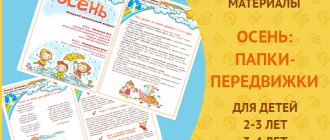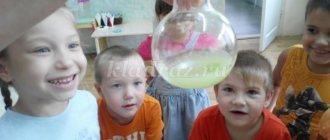What is a mixed age group
This is a group in which children differ from each other in age and development. Most often, such groups are taught in kindergartens. To create a multi-age group, it is not enough to simply gather children from 3 to 7 years old in one place. The group requires a special educational program: children study the same material, but older ones study at an in-depth level. Teachers also delegate some of the household and pedagogical tasks to the older children: the elders help the younger ones get dressed, put away the dishes, and explain tasks. Most often, multi-age education is used in kindergartens working according to the Montessori approach or within the framework of Waldorf pedagogy.
We improve our skills through special training
To have the right to work as a teacher of a combined group in a preschool educational institution, you need to take courses and gain relevant additional knowledge, the presence of which must be documented. My favorite “UchMag” offers an excellent opportunity to learn and receive a training certificate on the following topics:
- “Professional competence of a teacher in the context of the implementation of the Federal State Educational Standard for Education: additional education for preschoolers with disabilities”;
- “Inclusive practice in groups of combined orientation.”
It is worth saying that you can safely trust the quality of the information that you will hear in the webinar format. All materials are strictly in accordance with the Federal State Educational Standard, the certificates of this educational portal are also legal, in the established format.
What are the pros and cons of different age groups?
Accelerated development
. In a mixed-age group, younger and older children help each other communicate and learn. The younger ones develop faster, catching up with the older ones. The elders learn responsibility, and also “consolidate” knowledge and skills by helping the younger ones in everyday life and with tasks.
Model of society.
A group of children of different ages more closely resembles the real world - a child already in kindergarten understands the principles of communication in real life.
Development of emotional intelligence
. In such groups, children see a huge range of emotional reactions: some are upset because of the absence of their mother, others are happy about their first victories. Children learn to empathize and develop empathy. Many gain experience of communicating with peers other than their peers, which an only child in the family cannot get.
Minimum conflicts
. Peers may have more conflicts than children of different ages. In addition, children of different ages react differently in conflict: if a three-year-old is stubborn and does not share the toy, then a six-year-old will give in to the younger one or offer another way that will suit everyone.
Difficulties in adaptation
. In groups of different ages, it is more difficult for newcomers than in groups of peers. In such groups, some of the children leave the kindergarten, and new ones arrive at the beginning of the school year. They have to integrate into the existing structure of the group and much depends not on the children themselves, but on the attention of the teachers.
Little attention from teachers
. Some educators may place too much responsibility on older children and not pay enough attention to younger ones. Or, on the contrary, pay attention only to the younger ones, thinking that the older ones will cope on their own.
I'll add a few more words...
My friend’s son ended up through an acquaintance in a kindergarten for children with visual impairments, because it was more convenient for them. The boy was used to seeing children with glasses, squints, and poor vision. And when he got into a class where there was only one boy with glasses, he could not understand why they were laughing at him, because he simply had trouble seeing...
Remember, in our Soviet childhood, at school they teased everyone who was at least in some way different from the masses: bespectacled, lop-eared, too light-skinned, and vice versa - dark-skinned, plump and thin. To be like everyone else was considered commendable. Today, the humanity of society has nevertheless increased, it seems to me. There is much less teasing in children's groups and fewer offensive nicknames are given.
Do you think I'm right? Tell us how things are going with this in your children’s classes?
If the topic of the article seemed interesting to you, share it with your friends on social networks and please subscribe to the news.
Sincerely, Tatyana Sukhikh!
By the way, I recommend reading:
How to organize work in groups of different ages
Maintain age symmetry
. Mixed-age groups work effectively if they include peers for everyone. Ideally, there should be an equal number of children of each age in the group. This rarely happens in practice, but it is important that one six-year-old does not study in a group with three-year-olds. Such a group would not be considered truly diverse in age. Balance helps everyone find communication partners.
Arrange the environment
. Children of different ages have different play and learning needs. Therefore, it is important to create a developmental environment that suits everyone. The Reggio or Montessori approach is best suited for these tasks. It is zoned and children can go in small groups or individually to different corners. In the common area they can communicate with each other and play group games.
Experiment with the mode
. Most often, the daily routine suits all preschoolers at once, but the younger and older ones may not agree on small details. Younger children need a little more time to sleep, so older ones may need to be woken up later. Also, younger children need more time to dress and eat.
Learn to work in small groups
. Moreover, it is advisable to constantly change the composition of these groups, adhering to only one rule: each group should contain children of different ages. Working in small groups helps children communicate effectively. Also, in microgroups, older children better convey their experience to the younger ones.
Use rituals
. Although small group activities are effective, preschoolers should not forget that they are a group. Rituals help with this: a common circle at the end of the day, a password that must be said to enter the group, chants on the way to your site. Almost anything can be a ritual: for example, you can read fairy tales before bed, which the children choose in turn.
Pay attention to everyone
. You cannot shift responsibility to older children. It is important that everyone, both junior and senior, receives care from the teacher. Otherwise, older children gradually take on responsibility and demand power commensurate with it.
Conducting classes
The scheme for organizing classes in a mixed-age group was discussed above. Here are lesson plans in which classes are organized into subgroups.
- Summary of an educational lesson for a mixed-age group “Wild and Domestic Animals”, in which the difference in the selection of tasks for different ages is well presented.
- Summary of an open lesson in a mixed-age group on the topic “Winter. Winter fun." The lesson is discussed in detail for different age groups, there are many illustrations.
Below is a summary of the lesson, in which the lesson ends in stages for different groups.
Table: summary of an open lesson in a multi-age group of a kindergarten on the topic “In the forest of geometric shapes”, author Olga Filippova
In a group of different ages, if the topics coincide, classes can be conducted simultaneously with all children, calculating its duration for the average age, so that the deviation from the norm is insignificant:
- Mathematics lesson on the topic “The square got lost”, author Victoria Dikunova.
- An open lesson in a multi-age group of a kindergarten “Rules of Personal Hygiene” (Older children participate in staging skits).
Tasks of combined groups
Before I forget, I’ll remind you or, for those who don’t know, I’ll explain that combined groups should not be confused with compensatory groups. The first ones consist of healthy children and special ones, and the compensating ones are intended for kids with the same type of characteristics. More often these are problems of speech development. Today, almost every kindergarten has speech therapy groups, so they are compensatory.
About compensating groups, you can add one more thing: yes, children with speech disorders can be in combined groups, but if there are a large number of children with, say, speech disorders in the kindergarten, then it is easier and more expedient to teach them according to a specially developed correctional program. This way, correction of violations will be most effective.
The occupancy of compensating groups, in general, as well as combined groups, is within the limits of sanitary standards, no more than 16 people.
But let’s return to the tasks of combined groups:
- Providing an opportunity for children with disabilities to receive high-quality preschool education in preschool educational institutions;
- Construction of an educational program taking into account the characteristics of each child in an inclusive education environment;
- Ensuring the full maximum integration of children with disabilities into the team of ordinary children by creating a barrier-free space for the interaction of all members of the educational process;
- Organizing effective interaction with parents of pupils to create conditions for full development in preschool institutions and at home;
- Constant psychoprophylactic work with parents of healthy children and children with disabilities on the topic of creating a favorable psychological atmosphere in the group;
- Assistance to parents in the form of consultations and training on the issues of raising and developing children;
- Motivating parents of students to actively participate in the processes of learning and development of children, showing initiative and providing assistance to teachers;
- Correctional-pedagogical, medical, psychological and social correction of the condition of children with disabilities.
In other words, ordinary children and children with special needs should learn to respect each other from an early age and have equal opportunities for fulfillment.
The main thing is that everything is in accordance with the Federal State Educational Standard!
We wander in the “Labyrinth” in search of manuals
- Collection of lesson plans and notes by V. Gerbova “Speech development in a mixed-age group of kindergarten. Younger mixed-age group" is a good book for kindergarten teachers through introducing children to the world of fiction;
- A manual based on the Maria Montessori method “Multi-age group of children from 1 year to 3 years old” by Elena Hiltunen - suitable for both teachers and parents of babies.
I found thematic manuals for those who like to read books in electronic format on the liters portal:
- “Speech development in a mixed-age kindergarten group. Younger mixed age group. Lesson plans” by V. Gerbova – the material is simply and conveniently presented;
- V. Sterlikova “Speech development of children of primary preschool age (multi-age group)”;
- V. Gerbova “Notes of classes on speech development in the younger mixed-age group: 2-4 years.”
I also provide a link to download an excerpt file.
While I was looking for materials, I realized that in fact, there are a lot of them; you need to come across a good educational Internet platform in the form of online stores of methodological literature.
Of course, I couldn’t help but look for books and manuals for you on Ozone:
- “Game-based physical education classes in a mixed-age group” - excellent materials on the technology of creating inter-age sports and play space at home or in a preschool educational institution;
- “Teaching children play activities in a mixed-age group” is a similar manual, I liked it;
- “Multi-age non-formal education. Adult development resources" - here the influence of multi-age joint education and upbringing on the personality of an adult is considered. I think it’s an interesting manual; I plan to study it myself.
I really don’t know how it was possible not to find literature on programs for different age groups. Just dig, as they say, and it will float to the surface. I also found a good online store “Kniga.ru” - a huge selection of literature in different areas. Those who seek usually find, I know from myself.








